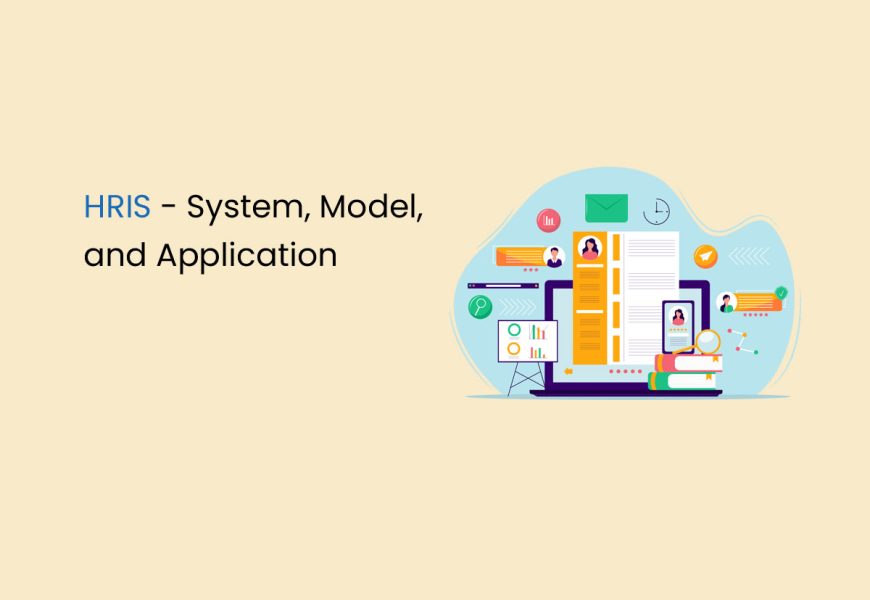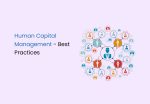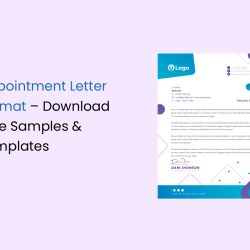HRIS have revolutionised how companies manage their human resources. In today’s competitive business landscape, technology like HRIS has become essential for growth and efficiency. In this context, it is crucial to understand what HRIS entails and its impact on both companies and employees.
Let’s explore this topic in further detail.
What is the Full Form of HRIS?
The full form of HRIS is Human Resource Information System. HRIS is a computer software that helps organisations maintain, manage, and process employee information and HR policies and procedures. It makes HR tasks more efficient and serves as an interactive system for managing data. The HRIS ensures accurate record-keeping and reporting.
An HRIS helps HR to manage recruitment details and employee performance, aid in their learning and development, and perform other essential business processes. It’s an intelligent database offering advanced functionalities that help simplify HR processes, making them more accessible and convenient. An HRIS can be run on the company’s technical infrastructure or through a cloud-based platform.
Functions of Human Resource Information System (HRIS)
The Functions of an HRIS are as follows:
- Applicant Tracking System (ATS): This software handles a company’s recruiting needs. It enables recruiters to track candidate information and resumes, match job openings with suitable candidates from the company’s application pool, and guide the hiring process.
- Payroll: It automates the process of paying employees. Payrolling involves entering contractual data and information on new hires, sometimes combined with time and attendance data. At the end of the month, payment orders are made based on this information.
- Employee Self-Service: Organisations nowadays are shifting their focus towards employee self-service. It allows employees and their supervisors to manage their own data. For example, employees can request leave, which is approved and recorded in the system immediately. It helps keep track of payroll and benefits accurately.
- Benefits Administration: Advanced systems offer employee self-service in choosing employee benefits. This means that employees can select the benefits that best suit their needs, such as paternity leave or a more expensive company car.
- Time and Attendance: Employees check into work using a fingerprint or card synced with an HRIS. This method gives an exact time for arrival and departure, and any lateness issues can be easily detected.
- Training: Employee development and growth is vital for effective employee management. HR can use a Learning Management System (LMS) to keep track of employee qualifications, certifications, and skills. The LMS also provides a list of available courses for employees, including e-learning courses.
- Performance Management: It is crucial to manage employee performance. Managers and peers evaluate and rate employees periodically to help identify strengths and areas for improvement and inform decisions on compensation, promotions, and training opportunities.
- Succession Planning: It’s critical to have a talent pool and replacement options in place for key roles. These can be managed with the help of an HRIS, which tracks and manages the entire employee lifecycle from recruitment to retirement. A strong HRIS ensures that organisations have the right people in the right roles at the right time, reducing the risk of disruptions caused by unexpected departures or vacancies.
- Reporting and Analytics: Modern HRIS systems provide automated HR reports on employee turnover, absence, performance, etc. Analytics involves analysing these insights to make better-informed decisions.
Benefits of Human Resource Information System (HRIS)
An HRIS is a powerful tool for any organisation’s HR department. The benefits of HRIS are as follows:
- It can expedite tasks, reduce paperwork, simplify predictive analysis and visualisations, empower employees, improve productivity, maintain compliance, and offer security and privacy.
- An HRIS automates specific tasks and streamlines processes, enabling HR staff to spend less time on clerical duties and more on strategic initiatives.
- It can help ensure the accuracy of employee data, reducing the risk of errors and inconsistencies.
- Employees can directly access and update their personal information without contacting HR, which can further streamline processes.
- A centralised repository for employee data eliminates the need for paper files, which can be easily damaged or lost.
- An HRIS can provide reporting and analytics capabilities, giving insights into important metrics such as headcount and turnover. It can even offer visualisation capabilities, such as automatically rendered organisational charts.
- An HRIS can also improve productivity by providing employee and manager self-service options, allowing for more efficient and timely processing of change requests.
- Approval workflows ensure that changes are reviewed and approved by the necessary individuals. Mobile capabilities can extend self-service options, providing additional flexibility for remote workers.
- An HRIS can help ensure that organisations stay compliant with relevant regulations. Many HRIS programs are designed with specific compliance regulations in mind and have monitoring capabilities.
- It can help organisations avoid legal issues, penalties, and financial losses.
- An HRIS can offer security and privacy protections for employee data, helping to protect sensitive personal information.
Different Types of Human Resource Information System (HRIS)
All HRIS systems have a few things in common, like automation, self-service, centralised databases, and talent management, to help HR professionals best perform their functions. Beyond that, different HRIS offer different sets of features. The types of HRIS are as follows:
Operational HRIS
Operational HRIS systems streamline HR tasks by managing employee records, position details, and performance appraisals. They equip HR managers with essential data for performance reviews, hiring, and promotions. They are ideal for organisations burdened with manual, repetitive HR tasks or scattered data. These systems centralise information, automate tasks, and enhance efficiency. Key benefits include task automation, suitability for standard HR functions, and applicability across various organisations.
Tactical HRIS
Tactical HRIS systems focus on resource-related processes like recruiting, training, compensation, and vacancies, aiding organisations in making strategic decisions on resource allocation, job analysis, and team development. Beyond internal data, they incorporate external factors such as union details, competitor insights, and regulatory requirements. They are ideal for organisations requiring macro-level decision-making support rather than daily operational support. These systems offer big-picture insights and optimisation of resource use, primarily catering to macro-level organisational needs.
Strategic HRIS
Strategic HRIS systems facilitate strategic analysis and decision-making for HR professionals, aiding in goal-setting, future workforce planning, and leveraging data such as market insights and operational budgets. They are particularly beneficial for organisations eyeing growth or expansion. These systems empower companies with concrete, data-driven insights to make informed strategic decisions. If your organisation aims to harness precise data for planning and expanding strategically, opting for a strategic HRIS is advisable, given its emphasis on data-driven decision-making tailored for growing companies.
Comprehensive HRIS
A comprehensive HRIS amalgamates operational, tactical, and strategic functionalities, serving as a centralised platform for managing many HR tasks. This all-encompassing system facilitates streamlined management across various HR domains, including employee data, recruitment, job analysis, safety protocols, skills inventory, compensation, training, and performance appraisal. Comprehensive HRIS platforms offer a complete HR management solution by consolidating information and operations under one umbrella. While they may entail higher costs and necessitate extensive training, their multifaceted capabilities can significantly revolutionise HR department functionalities, making them ideal for organisations seeking complete and integrated HR solutions.
Limited-Function HRIS
A limited-function HRIS is designed to serve a singular, specific purpose rather than encompassing a broad range of HR functions like a comprehensive system. These systems cater to distinct areas such as training, benefits management, or other specific HR tasks based on their design. They are particularly well-suited for smaller companies or departments. Limited-functioning HRIS solutions are often cost-effective, user-friendly, and efficiently managed even by a single HR professional. Their focused approach allows for targeted management of particular HR functions, making them ideal for organisations seeking streamlined solutions for specific HR needs.
Key Considerations when Choosing an HRIS
The things that help in choosing an Hris system are as follows:
- Understand your goals and objectives: Ensure your HR goals align with the organisation’s strategy, and consider long-term objectives to ensure HRIS supports growth and vision.
- Analyse your needs and challenges: Identify the needs of your organisation and the capabilities for the HRIS to maximise your team’s strengths while addressing HR inefficiencies.
- Assess your needed functionality: Ensure the HRIS system includes essential features such as payroll, team management, and annual leave management.
- Consider the type of HRIS system best suited to you: Evaluate the type of HRIS you need, such as operational, tactical, strategic, comprehensive, and limited-function systems.
- Evaluate your ROI: Perform a cost-benefit analysis to determine if the HRIS models provide a suitable return on investment. Evaluate time saved, error reduction, and potential future savings.
- Consider integration and compliance needs: Ensure that any HR systems you are considering are compatible with your current systems and comply with labour laws and data privacy regulations.
Human Resource Information System (HRIS) Analysts
HRIS analysts are responsible for maintaining the HRIS system in an organisation. They work with the HR and IT departments to ensure compliance with HR regulations, distribute necessary resources to employees, and organise equipment upgrades as required. In larger companies, HRIS analysts may focus on specific areas such as benefits administration, compensation management, or training programs, ensuring the HR system is thoroughly managed and optimised.
HRIS analysts offer benefits such as:
- They provide dedicated support to employees and management utilising the HRIS, ensuring seamless user experience and resolving queries promptly.
- HRIS analysts offer insights and recommendations based on meticulous analysis of HRIS processes and outcomes, aiding informed decision-making.
- They manage extensive data entry tasks, ensuring accurate and organised input of employee information into the HRIS.
- HRIS analysts prioritise the confidentiality and security of employee data, implementing robust measures to safeguard sensitive information.
- Analysts meticulously review and validate data entries, minimising errors and ensuring reliable reporting for informed HR strategies and actions.
What is an HRIS System?
An HRIS software system helps organisations manage their employees more effectively. It consists of two essential components:
- Organisational Design: Defining roles, functions, and reporting hierarchies to establish accountability and a clear pathway for operational functionality and consistency. With the right HRIS, organisations can address business challenges and put the right people in the right roles to achieve strategic goals.
- Employee Data Management: The HRIS provides a comprehensive view of each employee, including their name, address, date of hire, compensation, benefit selections, etc., and serves as a customer relationship manager in an employer/employee setting. By accessing this information, organisations can better connect with their employees, help them develop career plans, find the proper training, and improve their performance.
The HRIS automates and standardises record-keeping, reporting, and self-service functionality. This leads to more accurate and up-to-date information management, greater efficiency, and convenience for employees.
HRIS vs HRMS vs HCM
There is a key difference between the three similar-sounding terms. Here’s how they differ:
- HRIS was initially designed to maintain essential administrative employee records. It can also do HR processes like talent acquisition, recruitment, and comprehensive employee data management.
- HRMS is an advanced software solution to automate various HR tasks. It is often used interchangeably with HRIS. The modern HRIS systems have also incorporated payroll management and time and attendance tracking features.
- HCM offer advanced capabilities such as performance management, succession planning, compensation strategy, and strategic workforce planning. HCM provide a comprehensive framework for optimising human capital management across organisations.
The Challenges of Human Resource Information System (HRIS)
The most common challenges you can face with HRIS systems are as follows:
- Data Privacy and Security: HRIS systems contain confidential and sensitive information. It is crucial to ensure that every user who accesses the system can only view the information they are authorised to see. A sophisticated HRIS that provides customised access control can ensure that every user can access the information they need to perform their tasks while keeping other data secure.
- Regulatory Compliance: Organisations must ensure that their HRIS remains compliant with ever-changing regulations. The continuous monitoring and updates ensure the HRIS aligns with regulatory requirements, avoiding legal repercussions and reputational damage.
- Business Disruption: Organisations can struggle to adapt to changes, upgrades, and refinements. It is important to select an HRIS that aligns with organisational objectives and prioritises essential functionalities over distracting features to mitigate business disruption and maximise system utility.
Implementation of Human Resource Information System (HRIS)
You can implement an HRIS system successfully by following these steps:
- Draft a comprehensive plan: Create a comprehensive plan and outline all key milestones, timelines, and goals from start to finish.
- Gain senior management support: Secure the backing of senior management to obtain the necessary resources and authority for a successful implementation.
- Assemble a dedicated implementation team: To ensure a smooth and effective HRIS implementation, form a team of experts from HR, IT, and other departments.
- Select the right HRIS: Carefully consider your organisation’s unique needs, size, and budget, and then select an appropriate HRIS system.
- Consider security and privacy measures: Ensure the HRIS complies with all relevant data protection regulations and has top-of-the-line security features, like encryption, secure access controls, and regular security updates.
- Test your work: Test the HRIS before a full-scale implementation to identify and address any issues or gaps to ensure the system works as expected and meets the organisation’s needs.
- Constantly evaluate: Make continuous evaluation of the HRIS for regular updates and improvements. It ensures the system remains aligned with changing organisational needs and goals.
- Upkeep and maintain your HRIS: Regular maintenance and updates are crucial for the longevity, functionality, and security of your HRIS, as well as ensuring alignment with the latest HR and IT developments.
Future of HRIS Technology
HR technology is rapidly advancing to meet the demands of remote work and globalisation. As technology evolves, workplaces witness increased collaboration between humans and advanced systems. This collaboration offers business advantages but also risks dehumanisation. However, advancements enable HRIS to enhance the human experience at work. HRIS systems can use artificial intelligence (AI) and machine learning (ML) to address employee needs, streamline tasks, and simplify system upgrades. Organisations that embrace these HRIS innovations will harmonise human-tech collaboration, with HR driving this transformation.
Conclusion
The use of HRIS has revolutionised the way human resources management is handled. As technology advances, incorporating cutting-edge HR solutions such as HRIS will become essential for companies to remain competitive and promote a culture of ongoing development.
Frequently Asked Questions
What is HRIS?
The Human Resource Information System collects and stores data on an organisation’s employees, like their name, address, age, salary, benefits, performance reviews, etc.
What is an HRIS analyst?
HRIS analysts are responsible for maintaining an organisation's HRIS system. This includes researching and resolving problems and communicating with other departments, like finance.
What are the three types of HRIS?
There are five types of HRIS systems: operational, strategic, tactical, comprehensive, and limited-function. They are designed to address specific HR needs.
How long does it take to implement an HRIS?
The time it takes to implement an HRIS can vary depending on the organisation's size, the HR processes, and which HRIS will be implemented. It can take a few weeks to several months to implement an HRIS.
Can an HRIS be customised for specific organisational needs?
During your selection process, discussing your specific organisational needs with the HRIS provider is best. They offer customisation options such as custom reporting, workflow configurations, and user interfaces.
Are there different types of HRIS?
An HRIS can be a basic or comprehensive system that handles all HR tasks. It may be on-site or cloud-based or offer a hybrid solution.
Can I access HRIS remotely?
Modern HRIS, particularly cloud-based ones, can be accessed remotely.
Does an HRIS support employee self-service?
Modern HRIS provide employee self-service portals. Employees can manage their personal information, apply for leave, view their pay slips and benefits, and access company policies and documents.















